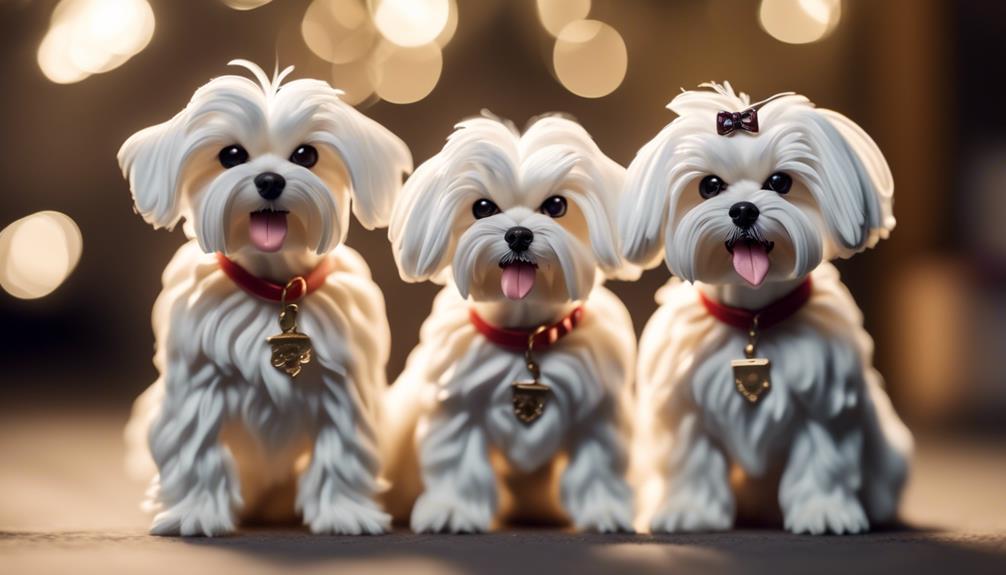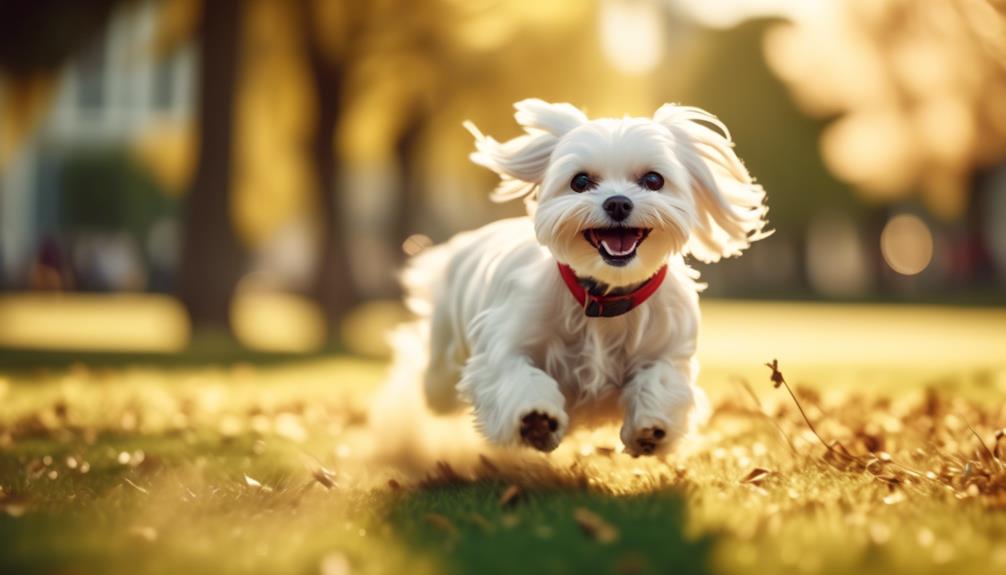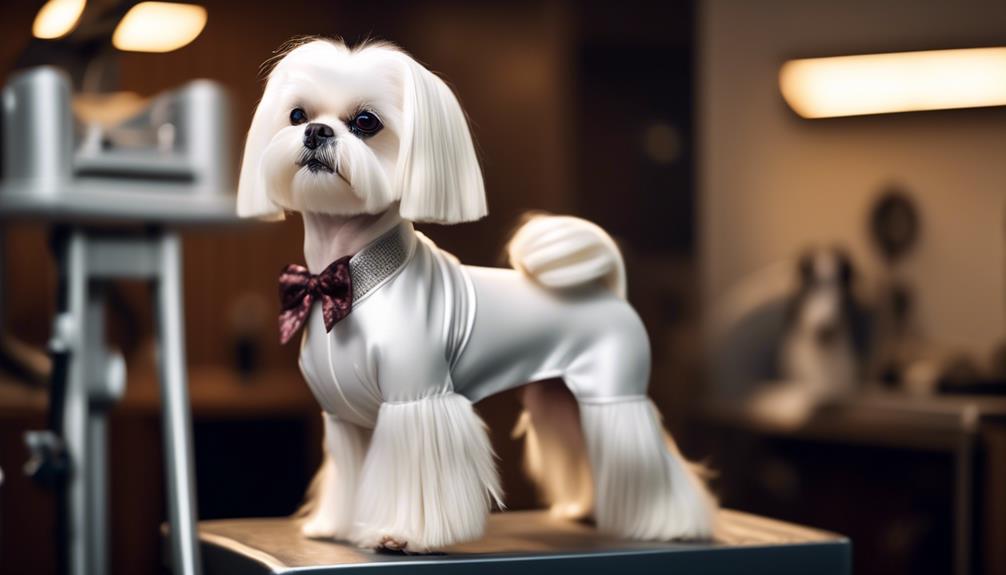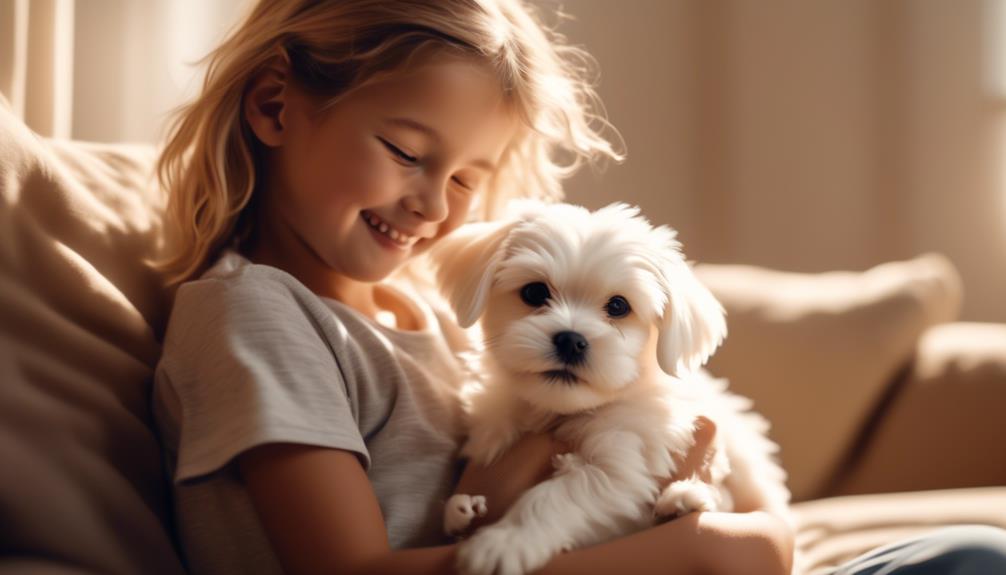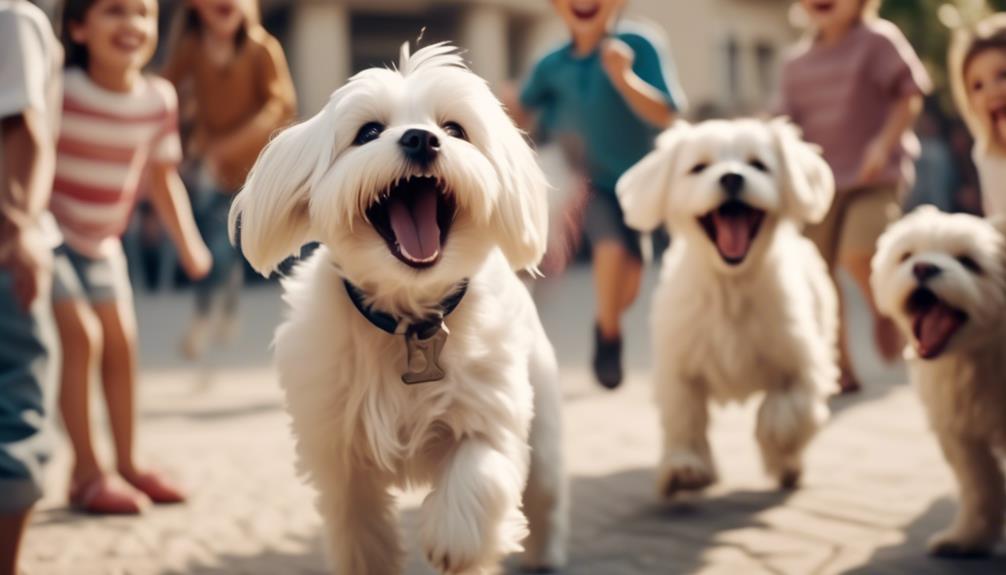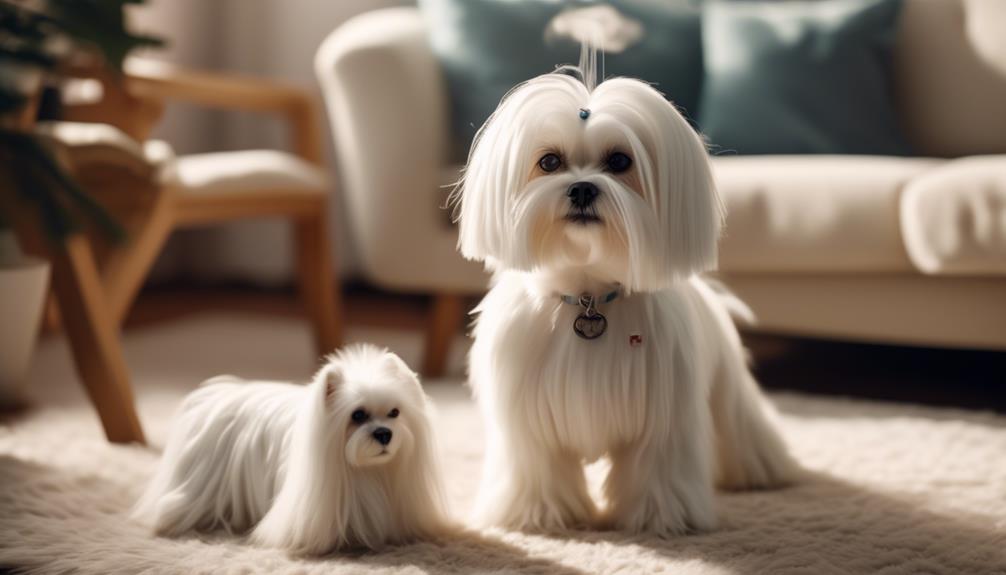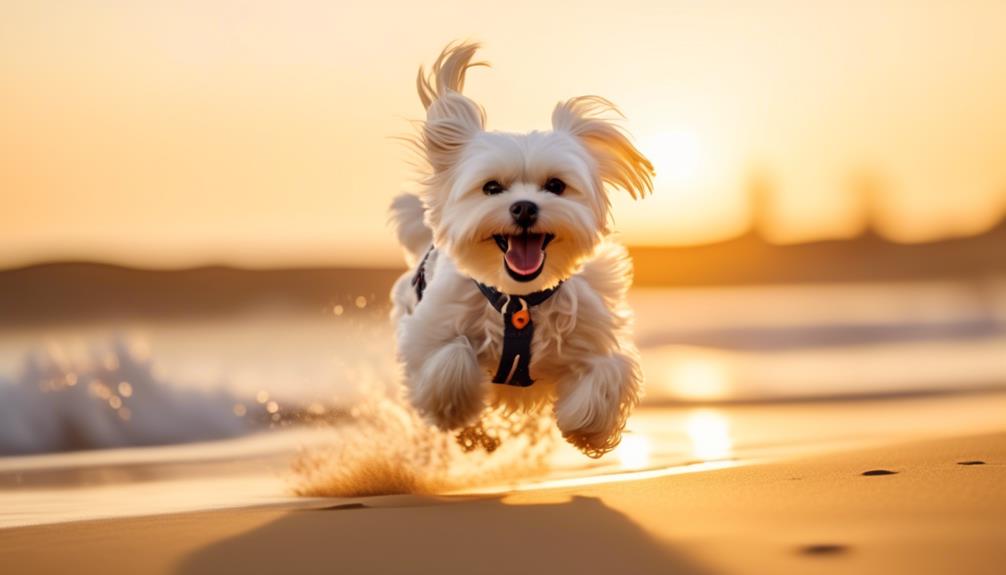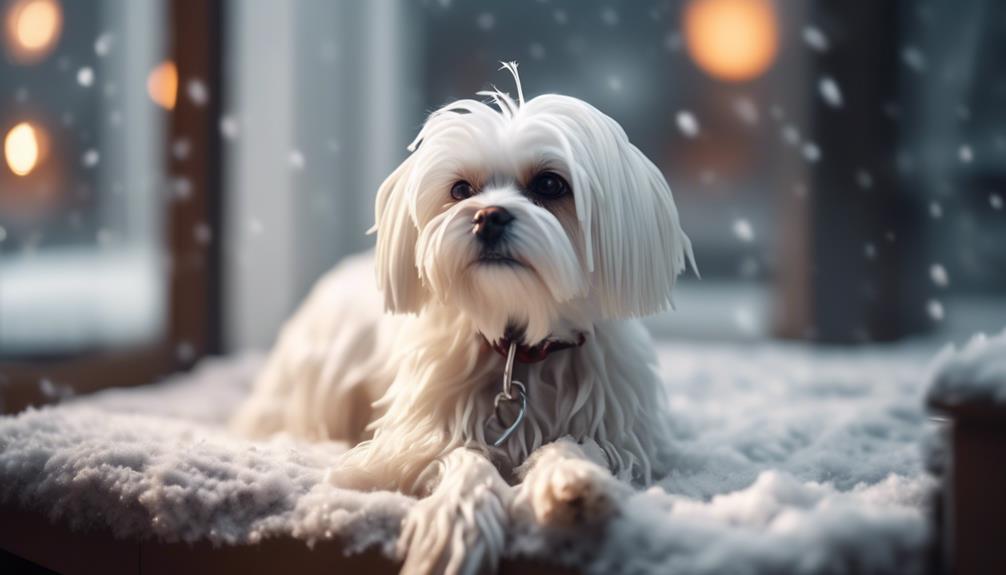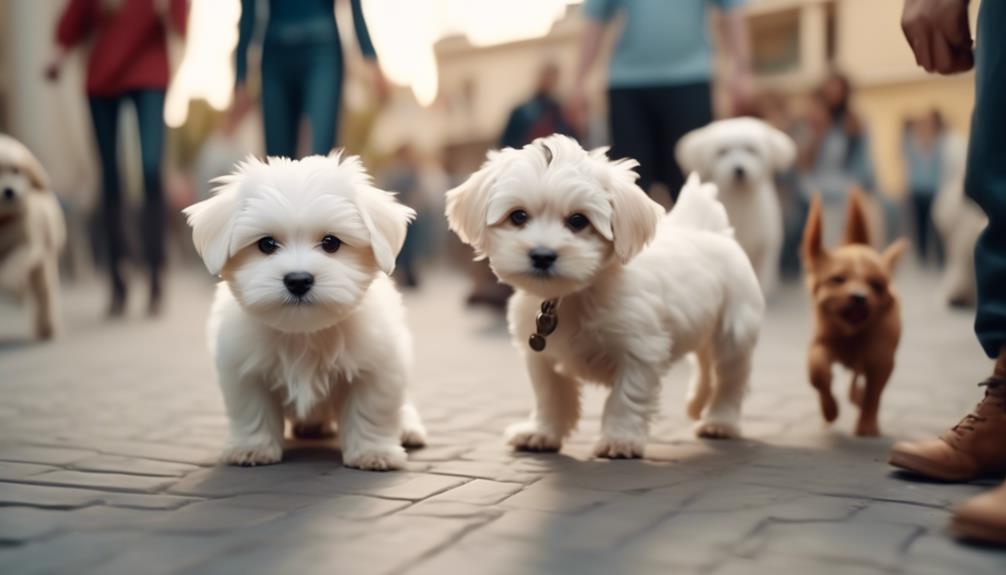With its shimmering white coat resembling a cloud of purity, the Maltese dog stands as a symbol of elegance and grace. But there’s more to this beloved breed than just their stunning appearance. As one delves into the world of Maltese dog breed information and characteristics, a fascinating journey unfolds, revealing a breed that is not only a delightful companion but also possesses a rich history, unique traits, and specific care requirements.
So, whether you’re considering adding a Maltese to your family or simply curious about these captivating canines, prepare to uncover a wealth of knowledge that will deepen your understanding and appreciation for this remarkable breed.
Key Takeaways
- Maltese dogs are small, gentle, affectionate, and playful companions with a long, silky white coat.
- They are intelligent and eager to please, making them well-suited for novice pet parents.
- Regular grooming, dental care, and veterinary check-ups are necessary to maintain their health.
- While they are good with children and can get along with other dogs and cats if socialized early, they are not recommended for families with young children and should be protected from larger dogs due to their small size.
Origin and Mediterranean Roots
The Maltese dog breed has its origins in the Mediterranean, specifically in the region of Malta. These small dogs belong to the toy breed group and have a lifespan of 12-15 years.
They’re known for their long, silky, and straight white coat, although some may have slight lemon or tan markings.
In terms of temperament, Maltese dogs are gentle, affectionate, playful, and alert. They’re intelligent and eager to please, making them well-suited for novice pet parents and apartment dwellers.
Maltese dogs are also good with children and make loyal companions. However, due to their small size, they aren’t recommended for families with young children and should be protected from larger dogs.
Many Maltese dogs are in need of adoption or fostering, and it’s important to prioritize adoption from rescue organizations or reputable breeders who prioritize the well-being of the dogs.
Size and Breed Group
Having explored the origins and Mediterranean roots of the Maltese dog breed, let’s now focus on their size and breed group. Maltese dogs are small in size and belong to the Toy breed group. As a Toy breed, they are known for their compact and petite stature, typically weighing between 4 to 7 pounds (1.8 to 3.2 kilograms) and standing at a height of around 8 to 10 inches (20 to 25 centimeters) at the shoulder. Despite their small size, Maltese dogs are full of personality and make excellent companions. Their small stature and gentle nature make them well-suited for apartment living and they are also a great choice for novice pet parents.
| Size |
Breed Group |
| Small |
Toy |
Lifespan and Health Considerations
What factors should be considered when discussing the lifespan and health considerations of Maltese dogs?
Maltese dogs typically have a lifespan of 12 to 15 years. While they’re generally a healthy breed, there are a few health considerations to keep in mind.
One of the main health issues that Maltese dogs are prone to is dental problems, such as tooth decay and gum disease. Regular dental care, including brushing their teeth and providing dental treats, is important in maintaining their oral health.
Additionally, some Maltese dogs may be prone to certain genetic conditions, such as luxating patellas (slipping kneecaps) and progressive retinal atrophy (a degenerative eye disease). Regular veterinary check-ups, preventive measures, and screenings can help detect and manage these conditions early on, ensuring a happy and healthy life for your Maltese companion.
Coat Characteristics and Grooming Needs
Considering the overall health and lifespan of Maltese dogs, it’s important to also address their distinctive coat characteristics and the grooming needs associated with them. The Maltese breed is known for its long, silky, and straight white coat, which requires regular grooming to keep it healthy and free from mats.
Here are four key points to note about the Maltese coat and grooming needs:
- Regular brushing and combing: Maltese dogs need daily brushing and combing to prevent tangles and mats from forming in their long hair.
- Weekly bathing: They should be bathed on a weekly basis to keep their coat clean and free from dirt and debris.
- Ear checks and hair removal: Regular ear checks are necessary to prevent infections, and the hair around the ears should be trimmed to keep them clean.
- Nail trimming: Maltese dogs have small, delicate paws, and their nails should be trimmed regularly to prevent them from becoming too long and causing discomfort.
Temperament and Personality Traits
The Maltese breed is known for its gentle and affectionate temperament, making them ideal companions for individuals or families seeking a loyal and playful pet. Maltese dogs are intelligent and eager to please, which makes them easy to train and a joy to have around. They are good with children and make loyal companions. Their alert nature also makes them good watchdogs. Here is a table summarizing the temperament and personality traits of the Maltese breed:
| Temperament |
Personality Traits |
| Gentle |
Affectionate |
| Playful |
Intelligent |
| Alert |
Loyal |
| Good with children |
Watchful |
| Eager to please |
|
Compatibility With Children and Other Pets
After discussing the temperament and personality traits of the Maltese breed, it’s important to consider their compatibility with children and other pets.
Maltese dogs are known for their gentle and affectionate nature, making them generally good with children. They’re patient and tolerant, making them suitable companions for kids of all ages.
When it comes to other pets, Maltese can get along well with other dogs and cats if they’re properly socialized from a young age. However, due to their small size, it’s important to protect them from larger dogs that may unintentionally harm them.
With proper introductions and supervision, Maltese can form harmonious relationships with other pets in the household.
- Good with children of all ages
- Can get along with other dogs and cats if socialized early
- Need protection from larger dogs
- Harmonious relationships possible with proper introductions and supervision
Suitability for Novice Pet Parents and Apartment Living
Novice pet parents and those living in apartments will find the Maltese breed to be a perfect fit for their lifestyle. These small and affectionate dogs are well-suited for apartment living due to their size and low exercise requirements. They’re content with indoor play and short walks, making them ideal for individuals who may not have access to a large yard or live in a busy city.
Additionally, Maltese dogs are known for their gentle and friendly nature, making them a great choice for novice pet parents who may be new to dog ownership. Their intelligence and eagerness to please also make them easy to train.
With their adaptable and loving personalities, the Maltese breed is an excellent choice for those looking for a companion in a smaller living space.
Adoption and Responsible Breeding
With their adaptability and loving personalities in mind, it’s important to consider both adoption and responsible breeding when looking to bring a Maltese dog into your life.
- Adoption: Opting to adopt a Maltese from a rescue organization or shelter is a compassionate choice that can give a deserving dog a second chance at a loving home.
- Reputable Breeding: If you decide to purchase a Maltese, it’s crucial to choose a reputable breeder who prioritizes the well-being of the dogs. Research breeders for ethical practices and ensure they conduct necessary health screenings for their breeding dogs.
- Health and Well-being: Responsible breeding helps to ensure that Maltese puppies are born in a nurturing environment and are less likely to inherit genetic conditions. It also reduces the risk of supporting puppy mills or backyard breeders.
- Overpopulation: Adoption and responsible breeding play a role in addressing the issue of dog overpopulation by providing homes for dogs in need and discouraging irresponsible breeding practices.
Exercise Needs and Activity Level
Maltese dogs have moderate exercise needs and an overall low activity level. While they do enjoy regular walks and outdoor play, they’re also active indoors and don’t require a lot of exercise. Being housedogs, they’re sensitive to extreme heat or cold and should be protected from such conditions.
A daily walk and some interactive playtime should be sufficient to meet their exercise needs. However, it’s important to note that every dog is unique, and their exercise requirements may vary. It’s always advisable to consult with a veterinarian or a professional dog trainer to determine the best exercise routine for your Maltese, taking into consideration their age, health, and individual preferences.
Sensitivity to Extreme Temperatures
Sensitivity to extreme temperatures is an important consideration when owning a Maltese dog. Due to their small size and high-maintenance coat, Maltese dogs are more susceptible to extreme heat or cold. Here are some key points to keep in mind:
- Maltese dogs have a low tolerance for hot weather and can easily overheat. It’s crucial to provide them with a cool and shaded environment, access to fresh water, and avoid excessive exercise during hot days.
- Similarly, they’re sensitive to cold temperatures and can quickly become chilled. It’s essential to keep them warm with appropriate clothing, limit their exposure to cold weather, and provide them with a cozy indoor space.
- Extreme temperatures can lead to health issues for Maltese dogs, such as heatstroke or hypothermia. It’s crucial to monitor their comfort and well-being closely and take immediate action if they show signs of distress.
- Regular grooming is essential for maintaining their coat’s insulation and protecting them from extreme temperatures. Keeping their coat clean, mat-free, and well-trimmed can help regulate their body temperature effectively.
Feeding and Dietary Requirements
When considering the care of a Maltese dog, it is important to understand their feeding and dietary requirements. Maltese dogs have small appetites and should be fed a high-quality, balanced diet that meets their nutritional needs. A recommended daily amount for Maltese dogs is 1/4 to 1/2 cup of high-quality dry food, divided into two meals. It is important to ensure that the food is appropriate for their size and age. Additionally, treats should be given in moderation to prevent weight gain. Owners should also provide fresh water at all times. Consulting with a veterinarian can help determine the specific dietary needs of a Maltese dog and ensure they receive the necessary nutrients for their overall health and well-being.
| Feeding and Dietary Requirements |
| – Feed 1/4 to 1/2 cup of high-quality dry food daily, divided into two meals |
| – Choose food appropriate for their size and age |
| – Treats should be given in moderation |
| – Provide fresh water at all times |
| – Consult with a veterinarian for specific dietary needs |
Regular Veterinary Care and Preventive Measures
Regular veterinary care and preventive measures are essential for maintaining the health and well-being of a Maltese dog. To ensure the best care for your Maltese, consider the following:
- Regular check-ups: Schedule regular visits to the veterinarian to monitor your Maltese’s overall health and catch any potential issues early on.
- Vaccinations: Keep your Maltese up-to-date on vaccinations to protect against common diseases and infections.
- Parasite prevention: Use flea and tick preventives to protect against external parasites, and administer heartworm prevention to safeguard against internal parasites.
- Dental care: Regularly brush your Maltese’s teeth and schedule professional cleanings to prevent dental problems and maintain good oral hygiene.
Importance of Socialization and Training
To ensure a well-behaved and confident Maltese dog, socialization and training are crucial aspects of their development.
Maltese dogs are naturally gentle and affectionate, but without proper socialization, they can become fearful or anxious in unfamiliar situations. Socialization helps them become comfortable with new people, animals, and environments, reducing the likelihood of aggressive behavior.
Training, on the other hand, helps establish boundaries and teaches them basic commands and good manners. As intelligent and eager-to-please dogs, Maltese respond well to positive reinforcement training methods. Training sessions should be short, engaging, and consistent to keep their attention.
It’s important to start socialization and training early in their lives to ensure they grow up to be well-adjusted and obedient companions.
Famous Maltese Owners Throughout History
Throughout history, many notable individuals have been proud owners of Maltese dogs. These beloved pets have found themselves in the care of famous figures from various walks of life. Here are four famous Maltese owners throughout history:
- Queen Elizabeth I: The legendary English queen was rumored to have a fondness for Maltese dogs. These elegant and loyal companions surely brought her joy during her reign.
- Mary Queen of Scots: Another royal figure, Mary Queen of Scots, also had a penchant for Maltese dogs. These small and affectionate pups likely provided her with comfort and companionship.
- Queen Victoria: The British monarch Queen Victoria was known for her love of animals, and Maltese dogs were no exception. Her fondness for these delightful and beautiful pets is well-documented.
- Elizabeth Taylor: The iconic actress was a known lover of toy-sized dogs, and she owned two Maltese dogs named Sugar and Daisy. Elizabeth Taylor’s adoration for the Maltese breed was widely recognized.
These famous individuals, among many others, have recognized the charm and companionship that Maltese dogs bring into their lives.
Considerations When Choosing a Dog
While famous Maltese owners throughout history have appreciated the charm and companionship these dogs provide, it is important to consider various factors when choosing a dog. One helpful way to make an informed decision is by considering the breed’s characteristics and specific needs. Here is a table that outlines some key considerations when choosing a dog:
| Consideration |
Description |
| Barking tendencies |
Some breeds are more prone to barking or howling than others. |
| Wanderlust potential |
Certain breeds have a higher tendency to wander or roam. |
| Exercise requirements |
Dogs have different energy levels and exercise needs. |
| Playfulness |
Some dogs are more playful and energetic than others. |
| Vocalization tendencies |
Consider the breed’s potential for barking, howling, or vocalizing. |
Frequently Asked Questions
Are Maltese Dogs Hypoallergenic?
Maltese dogs are hypoallergenic, making them a good choice for people with allergies. Their low-shedding coats produce less dander, reducing the risk of allergic reactions. Regular grooming can help maintain their coat and minimize allergens.
How Often Should I Bathe My Maltese?
Owners should bathe their Maltese dogs every 3-4 weeks to keep their coat clean and healthy. Over-bathing can strip the coat of natural oils. Regular brushing and grooming between baths is also essential to prevent mats and tangles.
Can Maltese Dogs Be Left Alone for Long Periods of Time?
Yes, Maltese dogs can be left alone for long periods of time, but they may experience separation anxiety. It is important to gradually train them to be comfortable alone and provide mental stimulation and toys to keep them entertained.
Are Maltese Dogs Good Guard Dogs?
Maltese dogs are not typically good guard dogs. While they may bark to alert their owners, they are generally gentle and affectionate, making them better suited as companions rather than protective watchdogs.
Can Maltese Dogs Be Trained to Do Tricks?
Yes, Maltese dogs can be trained to do tricks. They are intelligent and eager to please, making them receptive to training. With consistent and positive reinforcement, Maltese dogs can learn a variety of tricks.
Are Italian Greyhounds and Maltese dogs similar in their characteristics and traits?
Yes, Italian Greyhounds and Maltese dogs share some similar qualities despite their size difference. Both breeds exhibit affectionate and loyal behavior, often forming strong bonds with their owners. Additionally, they are known for their elegant appearance and playful nature. Understanding Italian Greyhound characteristics and information can help owners distinguish between the two breeds.
Conclusion
In conclusion, the Maltese dog is a beloved breed known for its beautiful coat, affectionate nature, and intelligence. They make excellent companions for families and individuals, and their small size makes them suitable for novices.
However, they require regular grooming and veterinary care to maintain their health. Proper socialization and training are also important for this breed.
With their long history and famous owners, the Maltese dog continues to capture the hearts of dog lovers everywhere.
